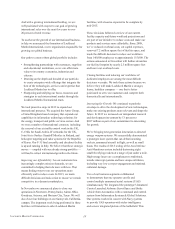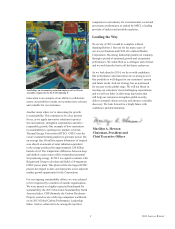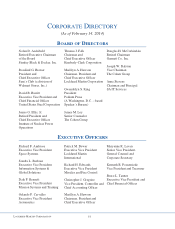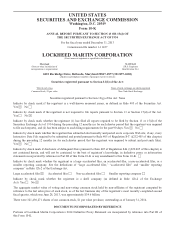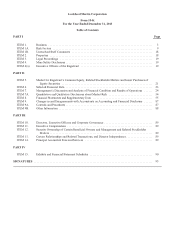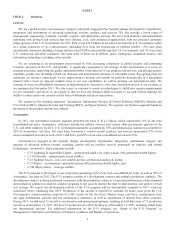Lockheed Martin 2013 Annual Report Download - page 16
Download and view the complete annual report
Please find page 16 of the 2013 Lockheed Martin annual report below. You can navigate through the pages in the report by either clicking on the pages listed below, or by using the keyword search tool below to find specific information within the annual report.The U.S. Government may terminate any of our government contracts and subcontracts either at its convenience or for
default based on our performance. If a contract is terminated for convenience, we generally would be protected by provisions
covering reimbursement for costs incurred on the contract and profit on those costs. If a contract is terminated for default, we
generally would be entitled to payments for our work that has been accepted by the U.S. Government, however, the U.S.
Government could make claims to reduce the contract value or recover its procurement costs and could assess other special
penalties. For more information regarding the U.S. Government’s right to terminate our contracts, see Item 1A – Risk
Factors. For more information regarding government contracting laws and regulations, see Item 1A - Risk Factors as well as
“Critical Accounting Policies – Contract Accounting / Sales Recognition” in Management’s Discussion and Analysis of
Financial Condition and Results of Operations.
A portion of our business is classified by the U.S. Government and cannot be specifically described. The operating
results of these classified programs are included in our consolidated financial statements. The business risks associated with
classified programs historically have not differed materially from those of our other U.S. Government programs. The internal
controls addressing the financial reporting of classified programs are consistent with the internal control practices for non-
classified contracts.
Our operations are subject to and affected by various federal, state, local, and foreign environmental protection laws and
regulations regarding the discharge of materials into the environment or otherwise regulating the protection of the
environment. While the extent of our financial exposure cannot in all cases be reasonably estimated, the costs of
environmental compliance have not had, and we do not expect that these costs will have, a material adverse effect on our
earnings, financial position, and cash flow, primarily because most of our environmental costs are allowable in establishing
the price of our products and services under our contracts with the U.S. Government. For information regarding these
matters, including current estimates of the amounts that we believe are required for remediation or cleanup to the extent
probable and estimable, see “Critical Accounting Policies – Environmental Matters” in Management’s Discussion and
Analysis of Financial Condition and Results of Operations and “Note 13 – Legal Proceedings, Commitments, and
Contingencies” of our consolidated financial statements. See also the discussion of environmental matters within
Section 1A - Risk Factors.
Backlog
At December 31, 2013, our backlog was $82.6 billion compared with $82.3 billion at December 31, 2012. Backlog is
converted into sales in future periods as work is performed or deliveries are made. Approximately $35.4 billion, or 43%, of
our backlog at December 31, 2013 is expected to be converted into sales in 2014.
Our backlog includes both funded (firm orders for our products and services for which funding has been both authorized
and appropriated by the customer – Congress, in the case of U.S. Government agencies) and unfunded (firm orders for which
funding has not been appropriated) amounts. We do not include unexercised options or potential indefinite-delivery,
indefinite-quantity orders in our backlog. If any of our contracts with firm orders were to be terminated, our backlog would
be reduced by the expected value of the unfilled orders of such contracts. Funded backlog was $55.0 billion at December 31,
2013, as compared to $54.8 billion at December 31, 2012. For backlog related to each of our business segments, see
“Business Segment Results of Operations” in Management’s Discussion and Analysis of Financial Condition and Results of
Operations.
Research and Development
We conduct research and development activities under customer-sponsored contracts and with our own independent
research and development funds. Our independent research and development costs include basic research, applied research,
development, systems, and other concept formulation studies. Generally, these costs are allocated among all contracts and
programs in progress under U.S. Government contractual arrangements. Costs we incur under customer-sponsored research
and development programs pursuant to contracts are included in net sales and cost of sales. Under certain arrangements in
which a customer shares in product development costs, our portion of the unreimbursed costs is expensed as incurred in cost
of sales. Independent research and development costs charged to cost of sales were $697 million in 2013, $616 million in
2012, and $585 million in 2011. See “Research and development and similar costs” in “Note 1 – Significant Accounting
Policies” of our consolidated financial statements.
Employees
At December 31, 2013, we had approximately 115,000 employees, about 95% of whom were located in the U.S.
Approximately 15% of our employees are covered by any one of approximately 60 separate collective bargaining agreements
8


